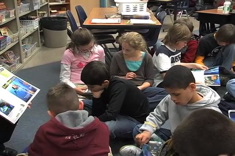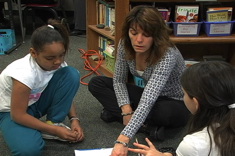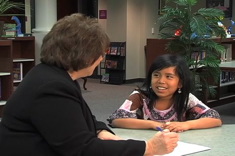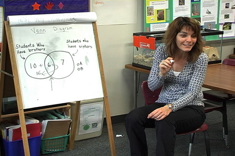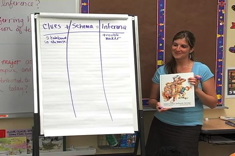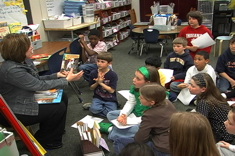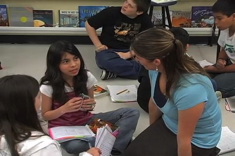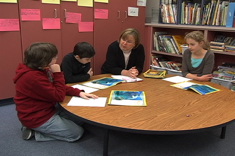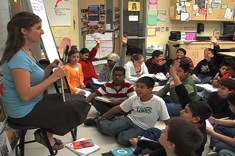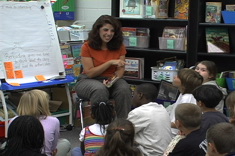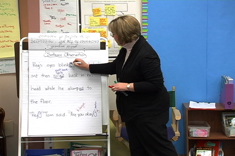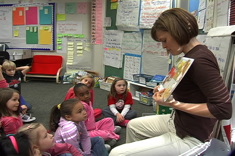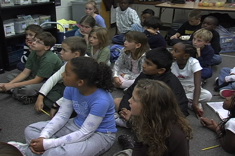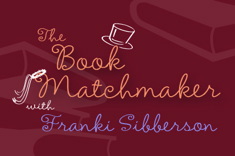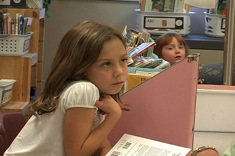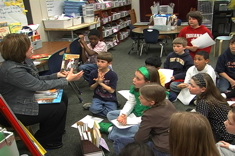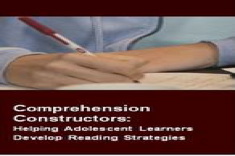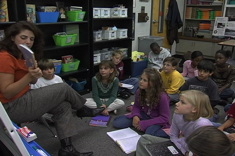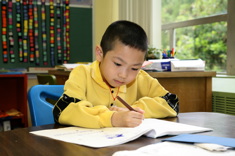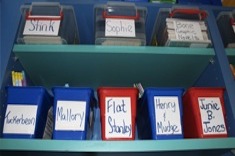Teaching Reading
Our contributors lead reading workshops in classrooms with creative flair. Over the past 12 years, we've filled our site with loads of suggestions, tools, and tips for using engaging books throughout the curriculum to hook kids on reading. Here is where you will find many stories of successful and not-so-successful workshop days, and what we learned from them. We bring these stories to life through hundreds of video examples.
Latest Content
Main Ideas in Nonfiction
In this whole-class lesson, 5th grade teacher Karen Terlecky and her students consider how main ideas work in nonfiction texts.
Conferring Close-Up: Test-Taking Strategies Part II
Andrea Smith confers with two 4th graders in her classroom as part of test preparation.
Student Reading Interview: Assessing Ana
Principal Karen Szymusiak interviews Ana, a second grader, to learn more about her strengths and needs as a reader.
Test-Taking Strategies Part III: Whole Class Debrief
Andrea Smith’s 4th graders debrief together after a test preparation workshop.
Inferring Read Aloud Part I
Katie Doherty demonstrates how she uses picture books to teach inferring strategies to her sixth graders in this video series. Part I is a presentation of the book to students.
Supporting Thoughtful Book Choice
In this video filmed in the spring, Franki Sibberson helps her 3rd and 4th grade students think through what books they might select for independent reading.
Teaching Inferring with Picture Books Part II: Partner Shares
Katie Doherty’s 6th grade students discuss the read-aloud through partner shares.
5th Grade Strategy Group on Summarizing
In this strategy group, Karen Terlecky brings together three of her 5th graders to reread a nonfiction article shared with the whole class. They discuss main ideas, and do a writing activity together to build summarizing skills.
Teaching Inferring with Picture Books Part III: Whole-Class Debrief
Katie Doherty's 6th grade students debrief after a read-aloud and partner share focused on inferring.
Teaching Rereading During Class Read Alouds
Aimee Buckner teaches her fourth graders the power of rereading using the mentor text Goblins in the Castle by Bruce Coville.
Keeping the M
Melissa Kolb confers with three-year-old Daniela and explains why approximations are crucial for young literacy learners.
Teaching Rereading Strategies Through Read Aloud Day 2
Aimee Buckner uses rereading as a strategy to deepen student understanding during read alouds.
5th Grade Sentence Observation
Karen Terlecky explains the sentence observation routine in her 5th grade classroom, and provides a video example of students in action analyzing sentences.
Picture Reading in First Grade
In this read-aloud lesson from Katie DiCesare's first-grade classroom, Katie demonstrates the importance of picture reading using the wordless picture book The Zoo by Suzy Lee.
From Questions to Drafts
Aimee Buckner shares the mentor text Could You? Would You? with her 4th grade students. Aimee explains how questions are a springboard to interesting writing topics, and models connections she makes to the text.
Book Matchmaker: Texts for “Outdoorsy” Boys
Those “outdoorsy” boys who love to fish and four-wheel all summer long can be a challenge to hook with books when they return to classrooms in the fall. This Book Matchmaker feature presents a video preview of new titles to entice these intermediate readers, as well as a print supplement of additional suggestions.
Narrative Nonfiction in Fifth Grade, Part 1
In this lesson from a fifth-grade classroom, Aimee Buckner guides students in a notetaking process to help them understand the qualities of nonfiction narrative writing.
From Cross Checking and Retelling to Main Ideas: Helping Advanced Readers Develop Skills
In this five-minute video, Gail Boushey confers with Amanda, a second-grade student reading at a fourth-grade level early in the school year.
Moving into “Big Fat Chapter Books”: Conferring with Elyse
In this conference with seven-year-old Elyse, Joan Moser helps her set a reading goal that will help her move into “big fat chapter books.”
Hooked on Series: Great Series Books for Transitional Readers
Finding the right series for a transitional reader is a gift. Franki Sibberson shares her favorite finds.
Planning for K-3 Author Studies (eGUIDE)
Gayle Brand knows the power of author studies and shares her activities, unit plans and year-long glances to support students identification as readers and writers.
Designing Comprehension Constructors: Helping Adolescent Learners Develop Reading Strategies (E-GUIDE)
Comprehension constructors are a terrific tool for helping teens record their understanding.
Moving Beyond the Basics: Teaching Inferring to a Fluent Young Reader
In this conference, Gail Boushey (of “The Sisters”) confers with Brandon and helps him understand the concept of inferring.
My Son Clark Kent
Lisa Koch shares a parent's perspective of the damage too much emphasis on reading levels in the classroom does to her young son.
Learning to Cross-Check: Conferring with Hailey
Joan Moser confers with five-year-old Hailey and helps her set a reading goal.
Comprehending Graphic Novels: A Primer for Teachers
Mary Lee Hahn provides a quick primer for teachers new to graphic novels, as well as suggestions for using these novels to teach comprehension.
Understanding the “Silent Period” with English Language Learners
Ruth Shagoury and Andie Cunningham explain how to support an English Language Learner who is not speaking with verbal and nonverbal communication strategies.
The Read-Around: Raising Writers
If there was a centerpiece to teaching writing that also brought students closer together, wouldn't you want to know about it? Read on about the Read-Around.
Chapter Book Read Alouds in the Primary Classroom
Shari Frost considers selection, preparation, and pacing in choosing books that work well as read alouds in the primary classroom.
Small Group Instruction: Inferring Focus
In this example of reading instruction with a small group, Gail Boushey of “The Sisters” leads a discussion of inference, using Peter Rabbit as a focus text. All of the children in the group are reading at different levels independently, but they share a goal of learning more about inferring.
Browse Content By
Type
Category
- Assessment Tools
- Big Fresh Archives
- Booklists
- Choice Numeracy
- Classroom Design
- Common Core
- Community Building
- Conferring
- Content Literacy
- Digital Literacy
- English Language Learners
- Equity
- Family Relations
- Free Samples
- Guiding Groups
- Leadership
- Literacy Coaches
- Mentor Texts
- Minilessons
- New Teacher Mentors
- Podcasts
- Poetry
- Quote Collections
- Reading Strategies
- Self Care
- Struggling and Striving Learners
- Talking and Listening
- Teacher Study Groups
- Teaching Reading
- Teaching Writing
- Word Study and Vocabulary
Author
- Melissa Quimby
- Nawal Qarooni
- Gwen Blumberg
- Julie Cox
- The Lead Learners
- Hannah Tills
- Josie Stewart
- Ruth Metcalfe
- Mallory Messenger
- Becca Burk
- Jodie Bailey
- Vivian Chen
- Mary Brower
- Tiffany Abbott Fuller
- Stephanie Affinito
- Ruth Ayres
- Leigh Anne Eck
- Heather Fisher
- Shari Frost
- Julie Johnson
- Suzy Kaback
- Gigi McAllister
- Shirl McPhillips
- Melanie Meehan
- Cathy Mere
- Debbie Miller
- Tara Barnett and Kate Mills
- Tammy Mulligan
- Dana Murphy
- Bitsy Parks
- David Pittman
- Brenda Power
- Heather Rader
- Matt Renwick
- Mandy Robek
- Christy Rush-Levine
- Gretchen Schroeder
- Jen Schwanke
- Brian Sepe
- Katherine Sokolowski
- Stella Villalba
- Jennifer Vincent
Grade Level
Choice Literacy Membership
Articles
Get full access to all Choice Literacy article content
Videos
Get full access to all Choice Literacy video content
Courses
Access Choice Literacy course curriculum and training

